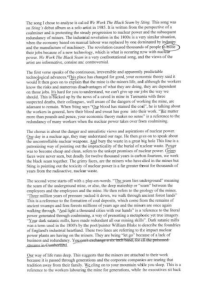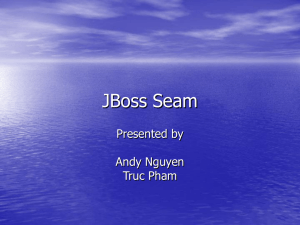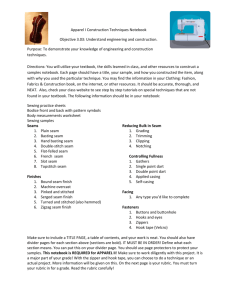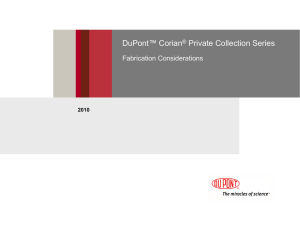STITCHES PER INCH (SPI)
advertisement
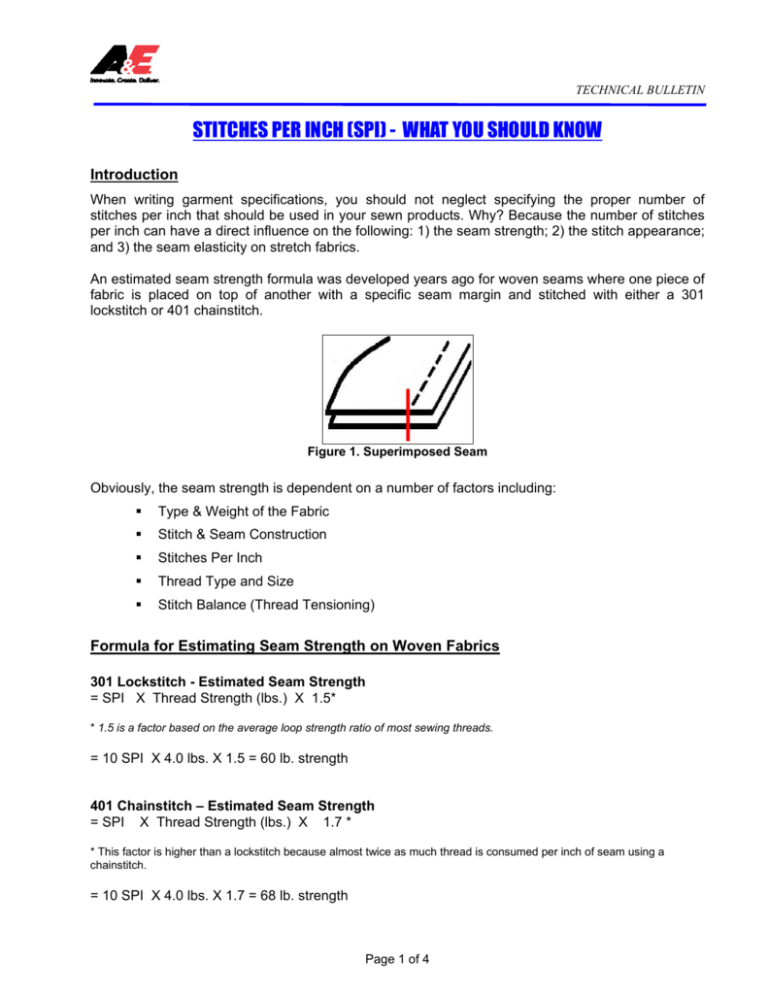
TECHNICAL BULLETIN STITCHES PER INCH (SPI) - WHAT YOU SHOULD KNOW Introduction When writing garment specifications, you should not neglect specifying the proper number of stitches per inch that should be used in your sewn products. Why? Because the number of stitches per inch can have a direct influence on the following: 1) the seam strength; 2) the stitch appearance; and 3) the seam elasticity on stretch fabrics. An estimated seam strength formula was developed years ago for woven seams where one piece of fabric is placed on top of another with a specific seam margin and stitched with either a 301 lockstitch or 401 chainstitch. Figure 1. Superimposed Seam Obviously, the seam strength is dependent on a number of factors including: Type & Weight of the Fabric Stitch & Seam Construction Stitches Per Inch Thread Type and Size Stitch Balance (Thread Tensioning) Formula for Estimating Seam Strength on Woven Fabrics 301 Lockstitch - Estimated Seam Strength = SPI X Thread Strength (lbs.) X 1.5* * 1.5 is a factor based on the average loop strength ratio of most sewing threads. = 10 SPI X 4.0 lbs. X 1.5 = 60 lb. strength 401 Chainstitch – Estimated Seam Strength = SPI X Thread Strength (lbs.) X 1.7 * * This factor is higher than a lockstitch because almost twice as much thread is consumed per inch of seam using a chainstitch. = 10 SPI X 4.0 lbs. X 1.7 = 68 lb. strength Page 1 of 4 TECHNICAL BULLETIN From this formula, you can see the impact that stitches per inch, thread strength and stitch selection have on the strength of the seam. Generally, the more stitches per inch, the greater the seam strength. There are rare cases where adding stitches per inch can actually damage the fabric so that the seam is weakened, however, this only happens on specific fabrics that can be damaged by excessive needle penetrations. Given: - 301 Lockstitch Superimposed Seam Thread Used Top & Bottom = T-24 Perma Core – Strength: 2.6 lbs. SPI Estimated Seam Strength 6 8 10 12 23.4 lbs. 31.2 lbs. 39 lbs. 46.8 lbs. As you can see from the chart above, the stitches per inch has a tremendous impact on the strength of the seam, as long as the fabric doesn’t rupture before the thread. If the same seams were sewn with a lower tenacity spun polyester thread, this also will effect the resulting seam strength. Given: - 301 Lockstitch Superimposed Seam Thread Used Top & Bottom = T-27 Spun Poly – Strength: 2.2 lbs. SPI Estimated Seam Strength 6 8 10 12 20 lbs. 26 lbs. 33 lbs. 40 lbs. Some manufacturers substitute a smaller bobbin thread when sewing lockstitch seams to minimize the number of times it takes the sewing operator to change the bobbin. Remember, however, that the resulting seam strength will be much less and will be determined by the strength of the bobbin thread and not the needle thread. How to Measure the Stitch Length or Stitches Per Inch? The stitch length is measured by measuring the number of lengths of thread found within one inch. Stitch counters are available from A&E that make this measurement easier, however, you can place a ruler next to the seam and perform the same task. Figure 2. Stitch Counter Measuring SPI SPI is measured by counting the number of lengths of thread found within one inch. As you can see here, there are approximately 9 SPI sewn in this seam. Page 2 of 4 TECHNICAL BULLETIN SPI Recommendations for Wovens & Knits Below is a list of garments and the typical number of Stitches Per Inch recommended for each of them. WOVEN GARMENTS Garments Denim Jeans, Jackets, Skirts Twill Pants or Shorts Trousers, Dress Pants, Slacks Dress Shirt or Blouse Casual Shirts, Blouses, Tops SPI 7–8 8 – 10 10 - 12 14 – 20 10 - 14 Comments Garments Fewer stitches per inch generally will give a more contrast stitch appearance. More stitches per inch will help minimize seam grinning. On some operations like serge panels, it may be desirable to use a longer stitch length. Using more SPI allows the use of smaller diameter threads that will minimize seam puckering. Using more SPI will give more of a tailored stitch appearance and better seam coverage when serging. Childrenswear Dresses, Skirts Blindstitch Operations on Slacks, Dresses, Skirts, etc. Buttonsew (4 hole button) Buttonhole (1/2” purl or whip stitch) SPI 8 - 10 10 - 12 3–5 16 85 - 90 Comments Usually 8 to 10 spi is adequate to provide adequate seam strength and at the same time allow for quicker cycle times . Due to many of the operations being lockstitch, usually 10 – 12 spi is required to provide adequate seam strength. A long stitch length is desirable to minimize the dimple or appearance of the needle penetration on the outside of the garment. Buttonsew machines are cycle machines with a predetermined number of stitches per cycle. Generally sewn vertically – approx. 8590 stitches with a lockstitch buttonhole machine. When setting standards for stitches per inch, you should always keep in mind that more stitches per inch used in a seam requires longer sewing cycles to complete the seam. Longer sewing cycles translates in to higher labor costs and lower production levels. A sewing machine sewing at 5,000 SPM (stitches per minute) at 8 SPI will sew 17.4 yards of seam per minute. A sewing machine sewing at 5,000 SPM at 14 SPI will sew 9.9 yards of seam per minute. More stitches per inch will also consume for thread per inch of seam. This will contribute to higher seam strength and more elastic seams, but will also increase the consumption of thread required to sew the garment. Page 3 of 4 TECHNICAL BULLETIN Therefore, the recommendations listed above are common stitch levels that provide adequate seam strength but also take into consideration the factors just mentioned. When sewing knit fabrics, you should always check for excessive “seam grinning” of the seam; and also check for “stitch cracking”. “Seam grinning” occurs when thread stitch balance is too loose allowing the seam to open up too much when stress is applied to it. “Stitch Cracking” is checked by applying pressure on the seam in the stitching direction. If the thread tensions are too tight or if you are not using enough stitches per inch, the threads will rupture as stress is applied on the seam. Therefore, the following recommendations have been made for the number of stitches per inch to be used on the following garments. KNIT GARMENTS Garments Jersey T-Shirts, Tops, Polos Underwear Infantwear Fleece Sweaters (Med. To Hvy.) SPI Comments Garments 10 - 12 Using more SPI increases the chance of needle cutting. 12 – 14 The more elastic the seam, the more SPI that should be used to minimize stitch cracking. 10 - 12 The more elastic the seam, the more SPI that should be used to minimize stitch cracking. 10 – 12 More stitches per inch are required to provide the proper seam coverage on fleece. 8 - 10 The more elastic the seam, the more SPI that should be used to minimize stitch cracking. Swimwear Dresses, Skirts Intimates Stretch Knits (Lycra®, Spandex®, etc.) Hosiery, Socks SPI 12 - 16 10 - 12 12 – 16 Comments The more elastic the seam, the more SPI that should be used to minimize stitch cracking. The more elastic the seam, the more SPI that should be used to minimize stitch cracking. The more elastic the seam, the more SPI that should be used to minimize stitch cracking. 14 - 18 More stitches per inch are required to provide the proper seam elasticity. 35 – 50 Usually sewn with very fine thread. More spi are required to minimize seam grinning and seam elasticity. Summary From the comments and information listed above, you can see how important adding specifications for Stitches Per Inch to your garment specification instructions. Using the correct number of stitches per inch can greatly enhance the strength, appearance and performance of the seam for a given fabric type and application. If you need assistance in determining what would be an adequate stitch level for your sewn products, please contact A&E’s technical service team for assistance. We look forward to serving you. Page 4 of 4
